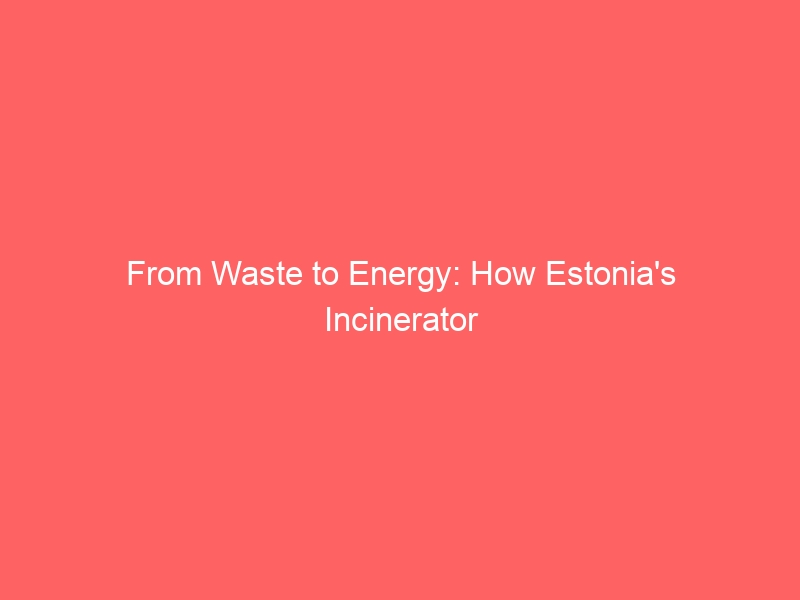From Waste to Energy: How Estonia’s Incinerator Is Changing the Country’s Environmental Landscape
Estonia, a small Baltic country in Northern Europe, has been making strides in recent years to improve its environmental sustainability. One key development has been the construction and operation of the country’s first modern waste-to-energy incinerator. This innovative facility is helping Estonia to reduce its reliance on landfilling, decrease greenhouse gas emissions, and generate renewable energy.
The waste-to-energy incinerator, located in the city of Tallinn, has been hailed as a game-changer for Estonia’s waste management and energy production. The facility, which came online in 2020, is capable of processing up to 220,000 tons of municipal solid waste per year, effectively turning it into electricity and heat. This represents a significant step forward for the country in its efforts to move towards a more circular economy and reduce its environmental impact.
The incinerator operates by burning the waste at high temperatures, typically around 850-1000°C, in a controlled environment. The heat generated from the burning process is then used to produce steam, which in turn drives turbines to generate electricity. Additionally, the heat can be used for district heating, providing a sustainable source of warmth for nearby residential and commercial buildings. This process of converting waste into energy is not only environmentally-friendly, but also helps to offset the need for traditional fossil fuels.
One of the key advantages of waste-to-energy incineration is its ability to divert a large portion of municipal waste from landfills. Landfilling is a major source of environmental pollution and releases harmful methane gases into the atmosphere. By incinerating the waste instead, Estonia can significantly reduce its greenhouse gas emissions and minimize the environmental impact of waste disposal. Moreover, the ash residue that remains after incineration is carefully treated and can be used in construction materials, thereby further reducing the need for landfilling.
The incinerator is not only a boon for the environment, but also for the economy. By producing electricity and heat from waste, Estonia is able to decrease its dependence on imported energy sources, such as coal and natural gas. This contributes to the country’s energy security and helps to stabilize energy prices. Additionally, the incinerator creates much-needed jobs in the waste management and energy sectors, providing economic benefits to local communities.
Furthermore, the waste-to-energy incinerator aligns with Estonia’s commitments to the European Union’s waste management and climate goals. The EU has been pushing for its member states to adopt more sustainable and circular approaches to waste management, with a particular emphasis on reducing the amount of waste sent to landfills. By investing in and implementing such innovative waste-to-energy technologies, Estonia is demonstrating its commitment to meeting these EU targets and contributing to a cleaner, greener Europe.
However, despite the numerous benefits of waste-to-energy incineration, it is not without its critics. Some environmentalists argue that incineration perpetuates the throwaway culture and diverts resources away from more sustainable waste reduction and recycling efforts. There are also concerns about potential air pollution from incineration, as well as the release of toxic substances from the burning process. It is important for waste-to-energy facilities such as Estonia’s incinerator to adhere to strict emission standards and employ state-of-the-art pollution control technologies to minimize environmental impacts.
In light of these concerns, it is crucial for waste-to-energy incinerators to be operated transparently and responsibly, with a focus on minimizing emissions and impacts on local communities. It is also important for authorities to continue to promote and incentivize waste reduction, recycling, and other sustainable waste management practices in parallel with waste-to-energy incineration.
Frequently Asked Questions (FAQs)
Q: What types of waste can be incinerated in the waste-to-energy facility?
A: The waste-to-energy facility in Estonia can incinerate various types of municipal solid waste, including household waste, commercial and industrial waste, and certain types of hazardous waste. However, specific regulations and guidelines govern the types of waste that can be accepted for incineration.
Q: How does the waste-to-energy incineration process impact air quality?
A: The waste-to-energy incineration process is designed to operate with the highest environmental and operational standards. Advanced pollution control technologies are employed to minimize emissions of pollutants, including particulate matter, nitrogen oxides, sulfur dioxide, and volatile organic compounds. Continuous monitoring of air quality is also conducted to ensure compliance with strict environmental regulations.
Q: What happens to the ash residue from the incineration process?
A: The ash residue from the incineration process is carefully collected and managed. It undergoes a treatment process to remove any remaining pollutants and is then recycled for use in various applications, such as construction materials.
Q: How does waste-to-energy incineration contribute to renewable energy production?
A: Waste-to-energy incineration generates renewable electricity and heat by utilizing the energy content of the waste. This reduces the need for fossil fuels and contributes to the production of sustainable energy.
Q: What are the environmental benefits of waste-to-energy incineration?
A: Waste-to-energy incineration diverts waste from landfills, reduces greenhouse gas emissions, and minimizes environmental pollution associated with traditional waste disposal methods. Additionally, it contributes to the conservation of natural resources and helps to address energy security concerns.
From Waste to Energy: How Estonia’s Incinerator Is Changing the Country’s Environmental Landscape




